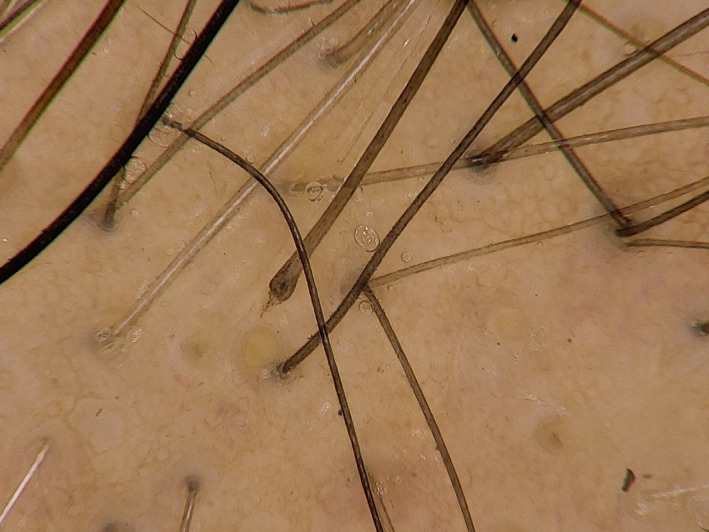Although cell receptors binding COVID‐19 appear to be less expressed in the skin compared to other organs, 1 skin lesions and hair loss are common manifestations of the disease (Supporting information S1,S2).
We recently observed 39 patients in Italy presenting with telogen effluvium, including 7 patients with severe trichodynia. These include 9 men and 30 women ageing 48 to 73 years (mean age 64.6). In 16 patients, COVID‐19 presented with severe interstitial pneumonia, requiring hospitalization and continuous positive airway pressure (CPAP) therapy. Medications included paracetamol (39) systemic steroids (25) anticoagulants (16). Symptoms developed eight weeks to three months after clinical manifestations COVID‐19. Laboratory examinations including thyroid function, iron, ferritin and vit B12 levels were within normal limits. These cases confirm that hair loss is an important clinical complication of SARS‐CoV‐2 virus infection, but also raises intriguing questions as to the underlying hair follicle (HF) pathobiology. Sixteen patients had severe interstitial pneumonia requiring hospitalization. History of anosmia and ageusia that had gradually resolved in 4 to 5 weeks, was present in 2/3 of cases. Hair thinning was often severe and patients reported having lost at least half their hair. Hair pull test was positive for telogen hairs. Scalp dermoscopy was performed in 18 patients. In 3 patients, a marked feature was the presence of empty follicular ostia and telogen club hairs visible on the scalp surface (Figure 1). Both hair loss and trichodynia resolved in 2 to 4 months.
FIGURE 1.

Dermoscopic image showing empty follicles and a telogen root on the scalp surface (50X) Absence of broken hairs exclude diffuse alopecia areata
TE is the most common form of diffuse hair shedding due to the premature termination of anagen and HF entry into catagen. TE was described among symptoms of the deadly influenza pandemic of 1918–19 (Supporting information S3), with hair loss reported to develop after a mean of 9 weeks after the onset of fever above 39.2 C (102.5 F) (Supporting information S4). In our cases, the time frame of 2 to 3 months and a positive pull test with extraction of telogen roots is consistent with this diagnosis. Trichoscopy definitely excluded anagen effluvium as there were not broken hairs or yellow dots. Although we believe that the COVID‐19 infection was the main trigger of the severe hair loss, other factors could have contributed including less frequent shampooing, worsening scalp health, medications such as anticoagulants and poor nutrition.
Pathobiologically, the COVID‐19‐associated systemic hyperinflammatory syndrome (“cytokine storm”) 2 is the most likely explanation of TE in the reported cases, given that most pro‐inflammatory cytokines such IL‐6, TNFa, IL‐1ß, IFNg all promote catagen development in murine and/or human HFs. 3 This explains recovery from TE after resolution of the “cytokine storm.”
Trichodynia has been associated with telogen effluvium and may be directly related to the severity of hair shedding and intensity (Supporting information S5). The combination of TE with trichodynia raises the question whether trichodynia may be a consequence of a similar neuropathology as the one leading to SARS‐CoV‐2‐induced ageusia and anosmia. In fact, we have recently shown that human scalp HFs can indeed “smell,” that is express functional olfactory receptors (namely OR2AT4), whose continuous stimulation by, as of yet, unknown endogenous ligand is required for anagen maintenance via intrafollicular insulin‐like growth factor‐1 production. 4 This raises the intriguing question whether COVID‐19, which causes major olfactory damage, 5 also reduces the HF expression of hair growth‐promoting olfactory receptors such as OR2AT4 causing anagen interruption. Moreover, angiotensin‐converting enzyme 2 (ACE2) receptors, used by the virus to enter human cells, are highly expressed in keratinocytes and sebaceous glands, although their functional role in HF biology remains unknown.
In summary, COVID‐19 is indeed associated with TE and trichodynia strongly encourages one to dissect the role of olfactory and ACE2 receptors, as well as IL‐6, in human HF biology and pathology to develop novel therapeutic strategies tailored to targeting these specific pathways.
CONFLICT OF INTEREST
ADL, LN and EG declare that they do not have any conflict of interest in connection with the paper. RP has been involved with industry‐sponsored research on the OR2AT4 ligand, Sandalore (see Cheret et al. 2018). AT is a consultant for DS Laboratories, Monat Global, Almirall, Tirthy Madison, Eli Lilly, Leo Pharmaceuticals, Bristol Myers Squibb, P&G.
AUTHOR CONTRIBUTION
ADL, LN and AT designed the research study, performed the research, analysed data and wrote the paper. EG and RP analysed data and wrote the paper.
Supporting information
S1‐S6: Supplement References.
REFERENCES
- 1. Criado PR, Pincelli TPH, Criado RFJ, Abdalla BMZ, Belda JW. Potential interactions of SARS‐CoV‐2 with human cell receptors in the skin: understanding the enigma for a lower frequency of skin lesions compared to other tissues. Exp Dermatol. 2020. [DOI] [PubMed] [Google Scholar]
- 2. Webb BJ, Peltan ID, Jensen P, et al. Clinical criteria for COVID‐19‐associated hyperinflammatory syndrome: a cohort study. Lancet Rheymatol. 2020;2(12):e754‐e763. [DOI] [PMC free article] [PubMed] [Google Scholar]
- 3. Ito T, Ito N, Saathoff M, Bettermann A, Takigawa M, Paus R. Interferon‐gamma is a potent inducer of catagen‐like changes in cultured human anagen hair follicles. Br J Dermatol. 2005;152(4):623‐631. [DOI] [PubMed] [Google Scholar]
- 4. Chéret J, Bertolini M, Ponce L, et al. Olfactory receptor OR2AT4 regulates human hair growth. Nat Commun. 2018;9:3624. [DOI] [PMC free article] [PubMed] [Google Scholar]
- 5. Gori A, Leone F, Loffredo L, et al. COVID‐19‐Related Anosmia: the olfactory pathway hypothesis and early intervention. Front Neurol. 2020;11:956. [DOI] [PMC free article] [PubMed] [Google Scholar]
Associated Data
This section collects any data citations, data availability statements, or supplementary materials included in this article.
Supplementary Materials
S1‐S6: Supplement References.


